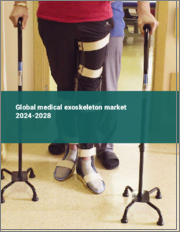
|
시장보고서
상품코드
1676276
세계의 의료용 외골격 시장 조사 보고서 : 산업 분석, 규모, 점유율, 성장, 동향, 예측(2025-2033년)Global Medical Exoskeleton Market Research Report- Industry Analysis, Size, Share, Growth, Trends and Forecast 2025 to 2033 |
||||||
세계의 의료용 외골격 시장 규모는 2024년 4억 7,000만 달러에서 2033년까지는 143억 1,000만 달러로 성장하며, 2026-2033년의 예측 기간 중 45.88%의 견고한 연평균 성장률(CAGR)을 보일 것으로 예측됩니다.
의료용 외골격 시장은 로봇공학과 인공지능의 발전이 재활 및 이동성 강화 솔루션에 접목되면서 큰 성장이 예상되고 있습니다. 이러한 웨어러블 로봇 장비는 운동 장애가 있는 사람들을 돕기 위해 설계되었으며, 뇌졸중, 척수 손상 및 기타 쇠약해진 상태로부터 회복된 환자의 삶의 질을 개선할 수 있는 유망한 수단을 제공합니다. 전 세계 인구가 고령화되고 만성질환의 유병률이 증가함에 따라 혁신적인 재활 기술에 대한 수요가 급증할 것으로 예상됩니다. 외골격에 스마트 센서와 머신러닝 알고리즘을 통합하면 외골격의 기능이 더욱 정교해져 사용자의 특정 요구와 진행 상황에 따라 맞춤화된 치료 요법을 적용할 수 있습니다.
또한 신흥 시장에서의 의료 인프라 확장은 의료용 외골격 부문에 유리한 기회를 가져다 줄 것입니다. 병원과 재활센터가 환자 치료 결과를 개선하기 위해 첨단 기술을 점점 더 많이 채택함에 따라 표준 치료 프로토콜에 외골격을 통합하는 것이 더욱 보편화될 것입니다. 기술 회사와 의료 서비스 프로바이더의 협력은 비용 효율적인 솔루션의 개발을 가속화하고 더 많은 사람들이 이러한 장비를 사용할 수 있도록 할 가능성이 높습니다. 또한 현재 진행 중인 경량 소재와 에너지 효율적인 설계에 대한 연구는 외골격의 사용 편의성과 편안함을 향상시켜 임상 및 가정 환경 모두에서 채택을 촉진할 것으로 예상됩니다.
의료용 외골격 시장의 미래는 규제 상황의 발전과 상환 정책에 따라 달라질 수 있습니다. 더 많은 임상 연구가 재활치료에서 외골격의 효과를 검증함에 따라 규제기관은 승인 절차를 간소화하고 혁신적인 제품의 빠른 시장 진입을 촉진할 것으로 예상됩니다. 또한 보험 상환 프레임워크가 확립되면 의료 서비스 프로바이더가 이러한 기술을 치료에 도입할 수 있는 동기를 부여할 수 있을 것으로 예상됩니다. 시장이 발전함에 따라 이동 보조뿐만 아니라 치료적 이점을 제공하는 다기능 외골격의 제작에 중점을 두게 될 것이며, 이는 재활 치료의 관행에 혁명을 일으키고 환자 치료를 강화할 것으로 예상됩니다.
이 보고서는 다양한 산업과 시장에 대한 종합적이고 실용적인 인사이트를 제공하기 위해 세심하게 작성되었습니다. 각 보고서는 시장 상황을 완전히 이해하기 위해 몇 가지 중요한 요소를 포함하고 있습니다.
시장 개요 : 정의, 분류, 산업 현황 등 시장에 대한 자세한 소개.
시장 성장 촉진요인 : 시장 성장에 영향을 미치는 주요 촉진요인, 억제요인, 기회 및 과제를 상세하게 분석합니다. 이 섹션에서는 기술 발전, 규제 변화, 새로운 동향 등의 요인을 검토합니다.
세분화 분석 : 제품 유형, 용도, 최종사용자, 지역 등의 기준에 따라 시장을 명확한 부문으로 분류합니다. 이 분석을 통해 각 부문의 성과와 잠재력을 파악할 수 있습니다.
경쟁 구도 : 시장 점유율, 제품 포트폴리오, 전략적 구상, 재무 실적 등 주요 시장 기업에 대한 종합적인 평가를 제공합니다. 주요 기업이 채택하고 있는 경쟁 역학 및 주요 전략에 대한 인사이트를 제공합니다.
시장 예측 : 과거 데이터와 현재 시장 상황을 바탕으로 일정 기간 중 시장 규모와 성장 추세를 예측합니다. 여기에는 정량적 분석과 미래 시장 궤적을 보여주는 그래프 표시가 포함됩니다.
지역 분석 : 지역별 시장 성과를 평가하고 주요 시장 및 지역 동향을 파악할 수 있습니다. 지역 시장 역학 및 비즈니스 기회를 이해하는 데 도움이 됩니다.
새로운 동향과 기회 : 현재 시장 동향과 새로운 시장 동향, 기술 혁신, 잠재적 투자 대상 분야를 파악합니다. 미래 시장 개발 및 성장 전망에 대한 인사이트를 제공합니다.
목차
제1장 서문
제2장 개요
- 시장의 하이라이트
- 세계 시장 스냅숏
제3장 의료용 외골격 산업 분석
- 서론 - 시장 역학
- 시장 성장 촉진요인
- 시장 성장 억제요인
- 시장 기회
- 업계 동향
- Porter's Five Forces 분석
- 시장의 매력 분석
제4장 밸류체인 분석
- 밸류체인 분석
- 원재료 분석
- 원재료 리스트
- 원재료 제조업체 리스트
- 주요 원재료의 가격 동향
- 잠재적 바이어 리스트
- 마케팅 채널
- 다이렉트 마케팅
- 인다이렉트 마케팅
- 마케팅 채널 개발 동향
제5장 세계의 의료용 외골격 시장 분석 : 컴포넌트별
- 개요 : 컴포넌트별
- 실적 데이터와 예측 데이터 분석 : 컴포넌트별
- 하드웨어
- 소프트웨어
제6장 세계의 의료용 외골격 시장 분석 : 유형별
- 개요 : 유형별
- 실적 데이터와 예측 데이터 분석 : 유형별
- 동력형 외골격
- 패시브 외골격
제7장 세계의 의료용 외골격 시장 분석 : 모빌리티별
- 개요 : 모빌리티별
- 실적 데이터와 예측 데이터 분석 : 모빌리티별
- 고정형
- 이동식
제8장 세계의 의료용 외골격 시장 분석 : 사지별
- 개요 : 사지별
- 실적 데이터와 예측 데이터 분석 : 사지별
- 하지
- 상지
- 전신
제9장 세계의 의료용 외골격 시장 분석 : 지역별
- 지역별 전망
- 서론
- 북미의 판매 분석
- 개요, 실적과 예측
- 북미 : 부문별
- 북미 국가별
- 미국
- 캐나다
- 멕시코
- 유럽의 판매 분석
- 개요, 실적과 예측
- 유럽 : 부문별
- 유럽 국가별
- 영국
- 프랑스
- 독일
- 이탈리아
- 러시아
- 기타 유럽
- 아시아태평양의 판매 분석
- 개요, 실적과 예측
- 아시아태평양 : 부문별
- 아시아태평양 국가별
- 중국
- 인도
- 일본
- 한국
- 호주
- 동남아시아
- 기타 아시아태평양
- 라틴아메리카의 판매 분석
- 개요, 실적과 예측
- 라틴아메리카 : 부문별
- 라틴아메리카 국가별
- 브라질
- 아르헨티나
- 페루
- 칠레
- 기타 라틴아메리카
- 중동 및 아프리카의 판매 분석
- 개요, 실적과 예측
- 중동 및 아프리카 : 부문별
- 중동 및 아프리카 국가별 리스트
- 사우디아라비아
- 아랍에미리트
- 이스라엘
- 남아프리카공화국
- 기타 중동 및 아프리카
제10장 의료용 외골격 기업의 경쟁 구도
- 의료용 외골격 시장의 경쟁
- 제휴·협업·합의
- 합병·인수
- 신제품 발매
- 기타 개발
제11장 기업 개요
- 상위 기업의 시장 점유율 분석
- 시장 집중도
- Parker Hannifin Corp
- Honda Motor Co. Ltd.
- Bioventus
- Hocoma
- Wearable Robotics Srl
- Cyberdyne Inc.
- Ekso Bionics
- ReWalk Robotics
- B-Temia
- Bionik
- Rex Bionics Ltd.
- ExoAtlet
- SuitX
- Myomo Inc.
- Wandercraft
Global Medical Exoskeleton Market size is anticipated to grow from USD 0.47 Billion in 2024 to USD 14.31 Billion by 2033, showcasing a robust Compound Annual Growth Rate (CAGR) of 45.88% during the forecast period of 2026 to 2033.
The medical exoskeleton market is poised for significant growth as advancements in robotics and artificial intelligence converge to enhance rehabilitation and mobility solutions. These wearable robotic devices are designed to assist individuals with mobility impairments, offering a promising avenue for improving the quality of life for patients recovering from strokes, spinal cord injuries, or other debilitating conditions. As the global population ages and the prevalence of chronic diseases rises, the demand for innovative rehabilitation technologies is expected to surge. The integration of smart sensors and machine learning algorithms into exoskeletons will further refine their functionality, enabling personalized therapy regimens that adapt to the user's specific needs and progress.
Moreover, the expansion of healthcare infrastructure in emerging markets presents a lucrative opportunity for the medical exoskeleton sector. As hospitals and rehabilitation centers increasingly adopt advanced technologies to enhance patient outcomes, the integration of exoskeletons into standard care protocols will become more prevalent. Collaborations between technology firms and healthcare providers are likely to accelerate the development of cost-effective solutions, making these devices more accessible to a broader demographic. Additionally, ongoing research into lightweight materials and energy-efficient designs will enhance the usability and comfort of exoskeletons, driving their adoption in both clinical and home settings.
The future landscape of the medical exoskeleton market will also be shaped by regulatory advancements and reimbursement policies. As more clinical studies validate the efficacy of exoskeletons in rehabilitation, regulatory bodies are expected to streamline approval processes, facilitating faster market entry for innovative products. Furthermore, the establishment of reimbursement frameworks will incentivize healthcare providers to incorporate these technologies into their treatment offerings. As the market evolves, the focus will shift towards creating multifunctional exoskeletons that not only assist with mobility but also provide therapeutic benefits, thereby revolutionizing rehabilitation practices and enhancing patient care.
Our reports are meticulously crafted to provide clients with comprehensive and actionable insights into various industries and markets. Each report encompasses several critical components to ensure a thorough understanding of the market landscape:
Market Overview: A detailed introduction to the market, including definitions, classifications, and an overview of the industry's current state.
Market Dynamics: In-depth analysis of key drivers, restraints, opportunities, and challenges influencing market growth. This section examines factors such as technological advancements, regulatory changes, and emerging trends.
Segmentation Analysis: Breakdown of the market into distinct segments based on criteria like product type, application, end-user, and geography. This analysis highlights the performance and potential of each segment.
Competitive Landscape: Comprehensive assessment of major market players, including their market share, product portfolio, strategic initiatives, and financial performance. This section provides insights into the competitive dynamics and key strategies adopted by leading companies.
Market Forecast: Projections of market size and growth trends over a specified period, based on historical data and current market conditions. This includes quantitative analyses and graphical representations to illustrate future market trajectories.
Regional Analysis: Evaluation of market performance across different geographical regions, identifying key markets and regional trends. This helps in understanding regional market dynamics and opportunities.
Emerging Trends and Opportunities: Identification of current and emerging market trends, technological innovations, and potential areas for investment. This section offers insights into future market developments and growth prospects.
SEGMENTATION COVERED IN THE REPORT
By Component
- Hardware
- Software
By Type
- Powered Exoskeleton
- Passive Exoskeleton
By Mobility
- Stationary
- Mobile
By Extremity
- Lower Extremity
- Upper Extremity
- Full Body
- COMPANIES PROFILED
- Parker Hannifin Corp
- Honda Motor Co. Ltd.
- Bioventus
- Hocoma
- Wearable Robotics srl
- Cyberdyne Inc.
- Ekso Bionics
- ReWalk Robotics
- B-Temia
- Bionik
- Rex Bionics Ltd.
- ExoAtlet
- SuitX
- Myomo Inc.
- Wandercraft
- The above list can be customized.
TABLE OF CONTENTS
1. PREFACE
- 1.1. Report Description
- 1.1.1 Objective
- 1.1.2 Target Audience
- 1.1.3 Unique Selling Proposition (USP) & offerings
- 1.2. Research Scope
- 1.3. Research Methodology
- 1.3.1 Market Research Process
- 1.3.2 Market Research Methodology
2. EXECUTIVE SUMMARY
- 2.1. Highlights of Market
- 2.2. Global Market Snapshot
3. MEDICAL EXOSKELETON INDUSTRY ANALYSIS
- 3.1. Introduction - Market Dynamics
- 3.2. Market Drivers
- 3.3. Market Restraints
- 3.4. Opportunities
- 3.5. Industry Trends
- 3.6. Porters Five Force Analysis
- 3.7. Market Attractiveness Analysis
- 3.7.1 Market Attractiveness Analysis By Component
- 3.7.2 Market Attractiveness Analysis By Type
- 3.7.3 Market Attractiveness Analysis By Mobility
- 3.7.4 Market Attractiveness Analysis By Extremity
- 3.7.5 Market Attractiveness Analysis By Region
4. VALUE CHAIN ANALYSIS
- 4.1. Value Chain Analysis
- 4.2. Raw Material Analysis
- 4.2.1 List of Raw Materials
- 4.2.2 Raw Material Manufactures List
- 4.2.3 Price Trend of Key Raw Materials
- 4.3. List of Potential Buyers
- 4.4. Marketing Channel
- 4.4.1 Direct Marketing
- 4.4.2 Indirect Marketing
- 4.4.3 Marketing Channel Development Trend
5. GLOBAL MEDICAL EXOSKELETON MARKET ANALYSIS BY COMPONENT
- 5.1. Overview By Component
- 5.2. Historical and Forecast Data Analysis By Component
- 5.3. Hardware Historic and Forecast Sales By Regions
- 5.4. Software Historic and Forecast Sales By Regions
6. GLOBAL MEDICAL EXOSKELETON MARKET ANALYSIS BY TYPE
- 6.1. Overview By Type
- 6.2. Historical and Forecast Data Analysis By Type
- 6.3. Powered Exoskeleton Historic and Forecast Sales By Regions
- 6.4. Passive Exoskeleton Historic and Forecast Sales By Regions
7. GLOBAL MEDICAL EXOSKELETON MARKET ANALYSIS BY MOBILITY
- 7.1. Overview By Mobility
- 7.2. Historical and Forecast Data Analysis By Mobility
- 7.3. Stationary Historic and Forecast Sales By Regions
- 7.4. Mobile Historic and Forecast Sales By Regions
8. GLOBAL MEDICAL EXOSKELETON MARKET ANALYSIS BY EXTREMITY
- 8.1. Overview By Extremity
- 8.2. Historical and Forecast Data Analysis By Extremity
- 8.3. Lower Extremity Historic and Forecast Sales By Regions
- 8.4. Upper Extremity Historic and Forecast Sales By Regions
- 8.5. Full Body Historic and Forecast Sales By Regions
9. GLOBAL MEDICAL EXOSKELETON MARKET ANALYSIS BY GEOGRAPHY
- 9.1. Regional Outlook
- 9.2. Introduction
- 9.3. North America Sales Analysis
- 9.3.1 Overview, Historic and Forecast Data Sales Analysis
- 9.3.2 North America By Segment Sales Analysis
- 9.3.3 North America By Country Sales Analysis
- 9.3.4 United States Sales Analysis
- 9.3.5 Canada Sales Analysis
- 9.3.6 Mexico Sales Analysis
- 9.4. Europe Sales Analysis
- 9.4.1 Overview, Historic and Forecast Data Sales Analysis
- 9.4.2 Europe By Segment Sales Analysis
- 9.4.3 Europe By Country Sales Analysis
- 9.4.4 United Kingdom Sales Analysis
- 9.4.5 France Sales Analysis
- 9.4.6 Germany Sales Analysis
- 9.4.7 Italy Sales Analysis
- 9.4.8 Russia Sales Analysis
- 9.4.9 Rest Of Europe Sales Analysis
- 9.5. Asia Pacific Sales Analysis
- 9.5.1 Overview, Historic and Forecast Data Sales Analysis
- 9.5.2 Asia Pacific By Segment Sales Analysis
- 9.5.3 Asia Pacific By Country Sales Analysis
- 9.5.4 China Sales Analysis
- 9.5.5 India Sales Analysis
- 9.5.6 Japan Sales Analysis
- 9.5.7 South Korea Sales Analysis
- 9.5.8 Australia Sales Analysis
- 9.5.9 South East Asia Sales Analysis
- 9.5.10 Rest Of Asia Pacific Sales Analysis
- 9.6. Latin America Sales Analysis
- 9.6.1 Overview, Historic and Forecast Data Sales Analysis
- 9.6.2 Latin America By Segment Sales Analysis
- 9.6.3 Latin America By Country Sales Analysis
- 9.6.4 Brazil Sales Analysis
- 9.6.5 Argentina Sales Analysis
- 9.6.6 Peru Sales Analysis
- 9.6.7 Chile Sales Analysis
- 9.6.8 Rest of Latin America Sales Analysis
- 9.7. Middle East & Africa Sales Analysis
- 9.7.1 Overview, Historic and Forecast Data Sales Analysis
- 9.7.2 Middle East & Africa By Segment Sales Analysis
- 9.7.3 Middle East & Africa By Country Sales Analysis
- 9.7.4 Saudi Arabia Sales Analysis
- 9.7.5 UAE Sales Analysis
- 9.7.6 Israel Sales Analysis
- 9.7.7 South Africa Sales Analysis
- 9.7.8 Rest Of Middle East And Africa Sales Analysis
10. COMPETITIVE LANDSCAPE OF THE MEDICAL EXOSKELETON COMPANIES
- 10.1. Medical Exoskeleton Market Competition
- 10.2. Partnership/Collaboration/Agreement
- 10.3. Merger And Acquisitions
- 10.4. New Product Launch
- 10.5. Other Developments
11. COMPANY PROFILES OF MEDICAL EXOSKELETON INDUSTRY
- 11.1. Top Companies Market Share Analysis
- 11.2. Market Concentration Rate
- 11.3. Parker Hannifin Corp
- 11.3.1 Company Overview
- 11.3.2 Company Revenue
- 11.3.3 Products
- 11.3.4 Recent Developments
- 11.4. Honda Motor Co. Ltd.
- 11.4.1 Company Overview
- 11.4.2 Company Revenue
- 11.4.3 Products
- 11.4.4 Recent Developments
- 11.5. Bioventus
- 11.5.1 Company Overview
- 11.5.2 Company Revenue
- 11.5.3 Products
- 11.5.4 Recent Developments
- 11.6. Hocoma
- 11.6.1 Company Overview
- 11.6.2 Company Revenue
- 11.6.3 Products
- 11.6.4 Recent Developments
- 11.7. Wearable Robotics Srl
- 11.7.1 Company Overview
- 11.7.2 Company Revenue
- 11.7.3 Products
- 11.7.4 Recent Developments
- 11.8. Cyberdyne Inc.
- 11.8.1 Company Overview
- 11.8.2 Company Revenue
- 11.8.3 Products
- 11.8.4 Recent Developments
- 11.9. Ekso Bionics
- 11.9.1 Company Overview
- 11.9.2 Company Revenue
- 11.9.3 Products
- 11.9.4 Recent Developments
- 11.10. ReWalk Robotics
- 11.10.1 Company Overview
- 11.10.2 Company Revenue
- 11.10.3 Products
- 11.10.4 Recent Developments
- 11.11. B-Temia
- 11.11.1 Company Overview
- 11.11.2 Company Revenue
- 11.11.3 Products
- 11.11.4 Recent Developments
- 11.12. Bionik
- 11.12.1 Company Overview
- 11.12.2 Company Revenue
- 11.12.3 Products
- 11.12.4 Recent Developments
- 11.13. Rex Bionics Ltd.
- 11.13.1 Company Overview
- 11.13.2 Company Revenue
- 11.13.3 Products
- 11.13.4 Recent Developments
- 11.14. ExoAtlet
- 11.14.1 Company Overview
- 11.14.2 Company Revenue
- 11.14.3 Products
- 11.14.4 Recent Developments
- 11.15. SuitX
- 11.15.1 Company Overview
- 11.15.2 Company Revenue
- 11.15.3 Products
- 11.15.4 Recent Developments
- 11.16. Myomo Inc.
- 11.16.1 Company Overview
- 11.16.2 Company Revenue
- 11.16.3 Products
- 11.16.4 Recent Developments
- 11.17. Wandercraft
- 11.17.1 Company Overview
- 11.17.2 Company Revenue
- 11.17.3 Products
- 11.17.4 Recent Developments



















